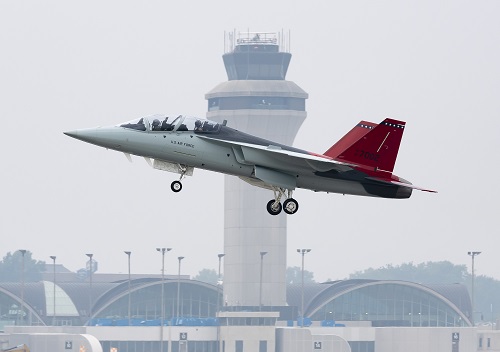Air Force flight testing for the T-7A Red Hawk kicked off June 28, with a USAF pilot flying the advanced trainer from contractor Boeing’s St. Louis, Mo., facilities. The event, announced by Boeing, marks the first official test flight conducted by an Air Force pilot and the beginning of the T-7’s engineering and manufacturing development phase.
Maj. Bryce Turner of the 416th Test Squadron and director of the T-7 Integrated Test Force and Boeing T-7 chief test pilot Steve Schmidt took the tandem-seat jet aloft for 63 minutes, checking the aircraft’s basic flying qualities, according to a Boeing release. In a statement, Turner reported the aircraft was stable in flight and “performs like a fighter.”
The first flight was in aircraft 21-7005, the first of five airplanes Boeing is providing to support the Air Force’s T-7A test program. Saab of Sweden is Boeing’s partner on the program and builds much of the mid-plane and tail of the trainer.
Boeing flew its pre-production prototype T-7As—called T-1 and T-2—during the T-X competition, which it won in 2019, and has since accumulated hundreds of hours on the two aircraft, verifying aspects of the design. Although retired Gen. Mike Holmes, then-head of Air Combat Command, flew one the two prototypes, the ride was not an official test flight. The aircraft that flew June 28 was the first of the production configuration, which differs from that of the prototypes.
The first flight with an Air Force pilot represents Boeing’s “commitment to delivering a new level of safety and training for fighter and bomber pilots,” said Evelyn Moore, vice president and T-7 program manager for Boeing. “We remain focused on engineering ways to better prepare warfighters for changing mission demands and emerging threats.”
The official start of testing was delayed several months as the Air Force and Boeing refined the escape system of the trainer, after ejection testing with manikins indicated unacceptable head and neck stress on pilots at the smaller end of the expected range of student pilot physiques. The trainer is the first USAF aircraft to be designed to accommodate a broad range of body sizes, with the specific intent of making USAF flying slots available to more women. The T-7 program is also grappling with some software and flight control issues.
The Air Force expects to buy 351 T-7As to replace its T-38 Talons, many of which are over 60 years old and will need further life extension due to delays in the T-7 program. The Government Accountability Office said in May the program will likely slip beyond the two years of delay already incurred.
Air Force acquisition executive Andrew Hunter told Congress in April that initial operational capability of the T-7A will not be achieved until 2027, compared to its original target of 2024 and a second benchmark of 2026 set in December 2022.
The Air Force zeroed its 2024 funding request for T-7A production on the assumption that it would not be able to begin production on time due to the ejection seat issue. The service has not said whether it may request a reprogramming of funds for that purpose. The fiscal 2024 request did include a forecast of 94 T-7As to be bought over the next five years, at a cost of $2.205 billion.
The next program milestone will be the Low Rate Initial Production (LRIP) decision, currently expected to be made by Pentagon acquisition and sustainment chief William LaPlante in November. However, the GAO questioned whether the Air Force can move ahead with LRIP, as testing will still be in its early stages by then and details of the production contract and program requirements may not be ironed out. The GAO also questioned whether the Air Force can accept jets ordered before ultimate specifications are set.
Boeing has said some of the program delay has been due to supply chain, labor issues, and inflation. It is developing the T-7 under a fixed-price contract. If fully exercised, the T-7 development and production contract is valued at about $9.2 billion.
